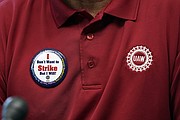UNITED Auto Workers President Shawn Fain is interviewed yesterday in Detroit. Fain, who won the UAW’s presidency this spring in the first direct election by members, says the union plans to go on strike against any Detroit automaker that doesn’t have an agreement by the time contracts expire next week. Photo: Carlos Osorio/AP
With Charlie Harper
EVERY year at the beginning of September, Americans pause as Labour Day, always celebrated on the first Monday in September, marks the end of another summer and the return to school for students and (at least traditionally) the return to the office or factory for white- and blue-collar workers alike.
The US is a real outlier in celebrating organised labour in September. More than 150 nations around the world designate May 1 as Labour Day or some variation on the same theme.
The Bahamas, commemorating a long-ago labour uprising, celebrates Labour Day on the first Friday in June in order to create a long weekend for workers. This date invites us to remember a significant workers’ strike that began on June 7, 1942.
This year, the stealthy return of a new COVID variant means that fewer workers will actually return to the office this year, but Labour Day also means that Americans are almost forced to consider the presence of organised labour. This is something they have only occasionally needed to do since the presidency of Ronald Reagan.
Over the past 40 years, American labour unions have seen their membership numbers dwindle. Reagan is given much credit for this, mostly for two reasons. First, his easygoing, wry humorous nature, general unpretentiousness and relaxed good looks endeared him to working-class Americans in a visceral, emotional fashion that challenged the long-standing political alliance between organised labour and the Democratic Party.
Reagan was a blue-collar favourite.
Secondly, only seven months after he took office and in what may have been a challenge to his still-developing leadership, the nation’s air traffic controller union called a strike in defiance of a presidential order to remain at work. The Reagan administration, citing valid national security and economic reasons, quickly fired the 11,345 striking air traffic controllers who had ignored the order, and banned them from federal service for life.
The union was decertified by Reagan’s Federal Labour Relations Authority on October 22, 1981. Union attempts to use the courts to reverse the firings proved fruitless.
After the firings and decertification, who would keep the skies safe and orderly? Under normal conditions, it took three years to train new controllers. Until replacements could be trained, the vacant positions were temporarily filled with a mix of non-participating controllers, supervisors, staff personnel, some non-rated personnel, military controllers, and controllers transferred temporarily from other facilities.
In the aftermath of this robust Reagan administration action, it took closer to ten years before the overall staffing levels returned to normal. Some former striking controllers were allowed to reapply after 1986 and were rehired; they and their replacements were now represented by the new National Air Traffic Controllers Association, which had no connection with the former union that led the strike.
Reagan had broken the old union, and organised labour in the US got the message. So too did union members, who increasingly wondered how their union dues were benefiting them.
But now, in addition to Labour Day, American organized labour is in people’s minds now for another reason. The US is facing a work stoppage by one of its most powerful entities, the United Auto Workers union.
In the heyday of the American labour movement, the UAW would target one of the “Big Three” Detroit automakers almost every three years when the union contracts expired. It was almost a foregone conclusion that a strike would ensue, and shock waves would reverberate throughout the American economy.
While Detroit is the acknowledged centre of American automaking, Michigan is far from the only state whose economy and jobs picture is directly dependent on the health and vitality of Ford, General Motors and Chrysler (now part of an international consortium with Fiat and others called Stellantis).
The economies of Wisconsin, Illinois, Indiana, Ohio especially, Pennsylvania and New York states are all heavily linked to Detroit automakers. Smaller cities of 30,000 or so throughout these states sustain themselves in significant ways from the contracts from the Big Three for everything from tyres to brake pads to manifold clips to spark plugs to windshields to … well, you get the picture.
Many observers still attribute Barack Obama’s somewhat surprising 2012 victory that ensured a second presidential term to his bold and aggressive bailout of the American auto industry starting in the previous year. Obama is credited with saving hundreds of thousands of Midwest jobs, and this led to his subsequent triumph in states that voted four years later for Donald Trump. The bailout won that election.
The introduction of largely non-union American manufacturing plants staffed by American workers but constructing Toyotas, Hondas, Hyundais, Kias, Mercedes and Volkswagens weakened the grip of the traditional Big Three, but only enhanced America’s love affair with the motor vehicle.
Over a period of decades, American-based automaking has remained a vital part of the national Gross Domestic Product. That makes a recent development pretty scary for the Biden administration and many others with a strong interest in the vitality of the current American economic recovery.
Now, for the first time in a long time, there is the threat by the UAW of a strike against one or more of the Big Three – likely Stellantis, but still possibly all three of them.
Biden, the legitimate heir to Reagan as the candidate with the greatest affinity for the working man and woman, has to be worried.
A key element in the current impasse is the rapid escalation of electric vehicle manufacturing. A possible strike date looms in around a week.
The talks are playing out as automakers are spending tens of billions of dollars to transition to electric vehicles, which require fewer workers to assemble than traditional gasoline-powered cars and trucks. The terms of any new contract will determine how both autoworkers and the companies fare in an EV-centric industry.
Historically, the UAW stare downs with the giant American automakers served as a bellwether for labour relations generally in the US. Some observers feel that significant wage and benefit gains for the union now could provide reinforcement for the revitalization of the American union movement that has been gaining strength in several other industries
Biden said: “The UAW deserves a contract that sustains the American middle class. The middle class did build America, and unions built the middle class. The need to transition to a clean energy economy should provide a win-win opportunity for auto companies and unionised workers. It should enable workers to make good wages and benefits to support their families, while leading us into a future where America is leading the way in reducing vehicle emissions and producing autos that will successfully compete domestically and globally. Companies should use this process to make sure they enlist their workers in the next chapter of the industry by offering them good paying jobs and a say in the future of their workplace.”
Ominously for the Democrats, the UAW has so far and surprisingly withheld any endorsement of Biden’s re-election bid, partly because of concern over the union’s share of EV-related jobs funded by federal subsidies.
One respected observer of the American auto industry told reporters that “the UAW leadership is in a position now where they have to prove to the members that they are fighting for them, so it’s pretty unlikely there won’t be a strike.”
According to several publications, the auto industry as a whole, including foreign-owned companies with operations in the United States, makes up about three percent of US GDP. A ten-day strike against the three Detroit automakers would result in total wage losses of $859m and manufacturers’ losses of $989m.
That’s a pretty big hit, despite the reality that the UAW is much smaller than it used to be, and that GM, Ford and Stellantis only employ about 150,000 UAW workers. Furthermore, those companies now make only around 40 percent of the cars and trucks sold in the US market.
Nevertheless, the UAW entered this year’s talks in a much stronger negotiating position than in recent years. In most of the last several contracts, GM, Ford and Stellantis had to get concessions on wages and benefits to survive. But in the year just past, the Big Three automakers racked up profits in the tens of billions of dollars, stoked by sales of SUVs and trucks.
We should know this month how things turned out.






Comments
Use the comment form below to begin a discussion about this content.
Sign in to comment
Or login with:
OpenID